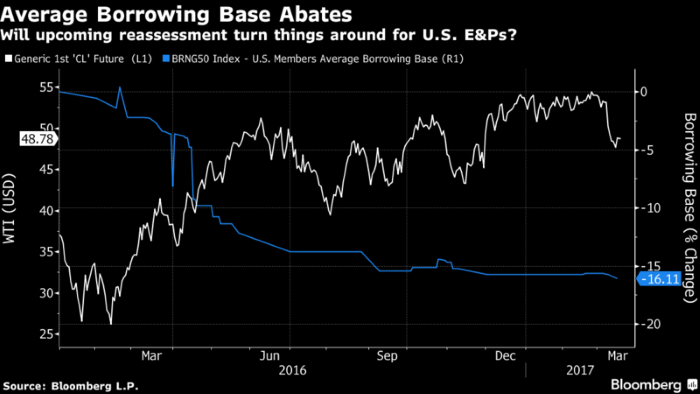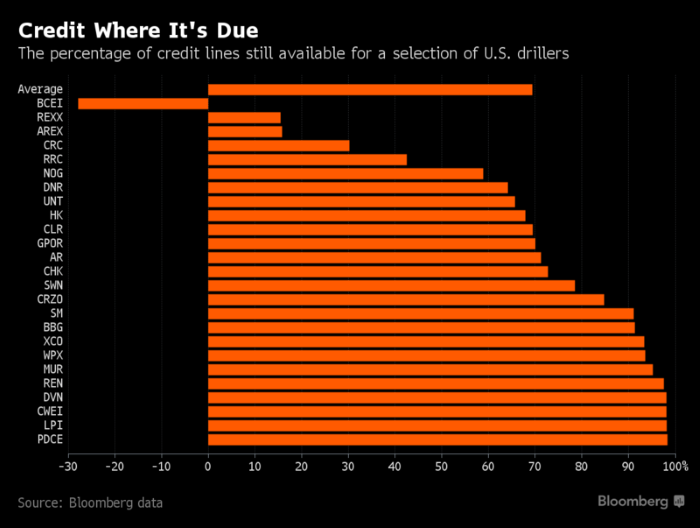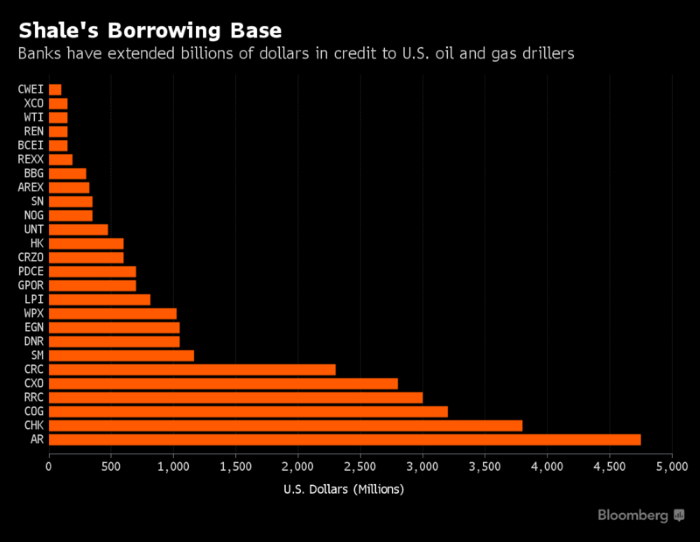The Oil Price Rally Is Stumbling at the Worst Possible Time

The rally in global oil prices has stalled at the worst possible time for explorers, just as banks reassess credit lines crucial to their growth.
This year’s reviews, due to start next month, will arrive with the industry nursing a nasty case of whiplash. Prices surged on OPEC’s pledge to cut output late last year, hitting $55.24 a barrel in New York in January. Since then, they’ve fallen by about 14 percent, undercut by rising U.S. rig counts.
A drop below $45 would likely spur credit-line reductions, raising the specter of cuts that crippled drillers a year ago, said Kraig Grahmann, a partner in Houston for law firm Haynes & Boone LLP. Between the end of 2015 and October, when credit lines were last reassessed, the average borrowing base for U.S. explorers fell 16 percent, according to data compiled by Bloomberg.
“The next month is going to be absolutely critical from an oil-price standpoint,” said Paul Grigel, a Denver-based analyst at Macquarie Capital USA, by telephone. “If you see prices retrench further, clearly the banks are going to have to re-evaluate. They are going to say, ‘Should we be pulling back?’”
West Texas Intermediate futures for May delivery fell 1.4 percent to $47.59 a barrel on the New York Mercantile Exchange at 12:15 a.m. Brent, the global benchmark, slipped below $50 for the first time Wednesday since November, after the U.S. reported crude stockpiles climbed to a record.
Credit reviews are “a combination of art and science,” Grigel said, with banks taking into account a company’s reserves, production trends and the future outlook for the market as well as current prices. Lenders can also be reluctant to cut credit lines if it would mean mortally wounding a borrower and raising the risk of default.
In late 2015, even with crude plunging, banks made relatively modest changes as they waited to see how the market would shake out.

Now it’s once again a precarious time for the industry. After a 2 1/2-year price rout was cut short by the OPEC deal, U.S. companies are exploiting new cost-saving drilling techniques to spark a level of growth that some fear could pave the way for yet another long-running slump in prices.
Industry budgets this year call for spending about $25 billion more collectively than in 2016, an 11 percent increase, according to a report last week from Wood Mackenzie Ltd. EOG Resources Inc. said it will increase capital spending 44 percent in 2017 to about $3.9 billion, whileContinental Resources Inc. will elevate spending 68 percent to $1.95 billion.
For many companies, credit lines remain a major determiner of how much growth they can achieve, said Spencer Cutter, a Bloomberg Intelligence analyst. The reassessments are traditionally done in April and October, when bankers will review both commodity prices and reserves, which are put up as collateral.
“This is their working capital,” Cutter said. “It’s how a lot of them fund their capital spending budgets for the year. It’s the blood that flows through the financial veins of the company on a day-to-day basis.”
For some companies, it’s not about growth, but survival.
Natural-gas driller Exco Resources Inc. said on March 15 that its borrowing base had been cut to $150 million, down from $285 million last year. The move was part of a financial rescue package in which the struggling company agreed to issue or swap $1 billion in new debt. The proceeds will help pay off money that Dallas-based Exco had already drawn on its credit line.

Last year, with crude prices tumbling below $30 a barrel, producers including W&T Offshore Inc. and Denbury Resources Inc. were hit with cuts of 30 percent or more.
That’s less likely this year, Cutter said. The surviving producers have emerged stronger after more than a year of cost-cutting and asset sales. And the run-up in prices after OPEC announced its supply cuts allowed oil and gas companies to lock in higher revenues through hedging contracts.
Still, companies that focus on natural gas, where prices have fallen faster, could be more vulnerable to credit cuts, Cutter said. The same goes for drillers without a major presence in the Permian shale basin, the lucrative drilling region in west Texas and New Mexico, said Macquarie’s Grigel.

If prices stay steady, there may be no change from the banks, according to Haynes & Boone’s Grahmann. It’s also possible oil could move back over $50 before the reassessments end. Even so, bankers would need “some kind of sign” that there’s long-term support for the increase, according to Grahmann. His firm tracks energy financing.
The start of the year “was definitely not a good time for a price drop,” Grahmann said. “The pause that the market has taken recently has caused some bankers to be a little bit more cautious about assuming that every run-up will last.”
Source: Bloomberg
HEADLINES
- Do shipping markets want Biden or Trump for the win?
- All 18 crew safe after fire on Japanese-owned tanker off Singapore
- Singapore launching $44m co-investment initiative for maritime tech start-ups
- Cosco debuts Global Shipping Industry Chain Cooperation Initiative
- US warns of more shipping sanctions
- China continues seaport consolidation as Dalian offer goes unconditional